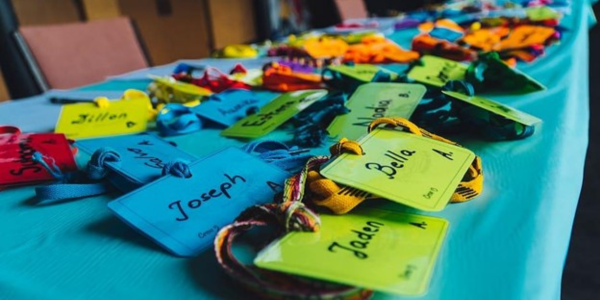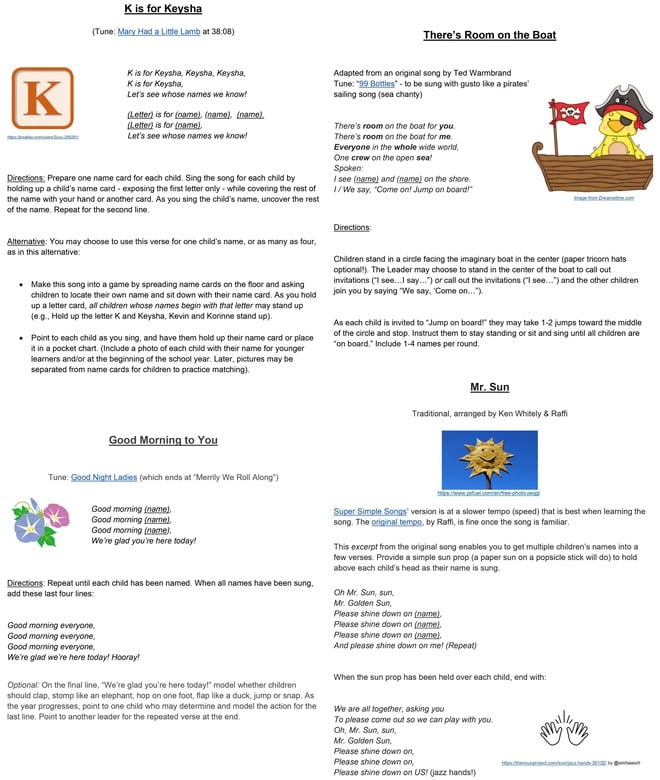Building Community Using Name Songs

Name Songs For Building Community
One of the earliest and most important strategies teachers develop each school year is establishing positive sense of community among disparate learners. Creating an inviting, engaging space is a useful plan. Making common materials as accessible as possible, with clear rules for use and storage, helps foster children’s sense of independence. Establishing simple expectations for conduct empowers children to maximize their own positive behaviors and learn how to manage their emotions in a safe, respectful way. But above all else, the most important part of the grand design is to quickly learn each child’s name and encourage others' (children and adults) who will interact with your children to learn them promptly, too.
A child’s name provides their first sense of identity. It is the first gift received from their parents and often carries a family legacy, emotional ties, cultural connections, and represent parents’ dreams for their child. Their name is their first means of being recognized, publicly and privately and serves as the first manner of introduction when meeting someone new. Important names are also typically the first words a child learns to write. Names can carry power, pride, ancestry, history, love, and story.
So it is easy to understand why learning all your students’ names with correct pronunciation is so crucial to establishing a positive connection with each child from the very start. It is also vital to assist others in learning each other’s names and correct pronunciation, lest any child go home feeling shame or embarrassment about their most personal form of identity.
Name familiarity builds a sense of community, increases engagement, fosters belonging and comfort, and increases the children’s sense of accountability to others in the class. Hearing one’s name used positively and frequently promotes self-worth, trust, and a positive attitude toward the learning environment.
Names can be tricky to learn when they are all new, and the faces have not yet been matched to their proper names. We know that the natural repetition of songs helps embed new information in the brain, so here are some fun, classroom-tested songs that build in the necessary repetition to jump-start everyone’s name learning!

These songs use generally familiar tunes but a link is provided if you need to hear it on the handy download below:
Saying a child’s name correctly immediately tells the student, “I care about you. You belong here.” Expressing a desire to learn the child’s name, even if pronouncing it is challenging at first, tells the student (and classmates) that you are inclusive and that each student is valued and respected. This sets the tone for the class and for the year and promotes bonding between children. Singing Name Songs encourages children to learn their classmates’ names and supports a sense of community and belonging. Sing your way into the new year!
Materials
Letter and Number Construction
Upper Case, Lower Case & Numbers Alphabet Stamps Set
Braille Alphabet and Numbers Set (upper & lower case) or Hand Signs Alphabet - Note that you would need two sets for children to be able to spell their names
Dough & Paint Stampers (upper case)
Writing Claw (adaptive pencil grip)
Colors of the World Washable Crayons
Pocket Chart with Sentence Strips
Freepik - free clipart and images
How to Make a Simple Paper Tricorn (Pirate/Sailing) Hat - white curls optional
References
Kertesz, Csaba and Ferenc Honbolygó. 2021. Frontiers in Psychology. Tapping to Music Predicts Literacy Skills in First Grade Children.
Kuhlman, Kristyn and Lawrence.J. Schweinhart. 1999 Timing in Child Development.
Poorvu Center for Teaching and Learning, Yale University. Learning Children's Names and Pronouns.
Linsteadt, Julia. Cut Out Kids. "Mr. Sun"
Books & Other
Andy, That’s My Name by Tomie dePaola - Andy has a wagon full of letters that spell his name!
Chrysanthemum by Kevin Henkes - Chrysanthemum learns to appreciate her unusual name when her teacher shares her own unusual name.
My Name is Yoon by Helen Recorvits
That’s Not My Name! by Anoosha Syed
G My Name is Girl by Dawn Masi - Girls from 26 countries share their names that begin with each letter of the English alphabet along with their unique interests. A world map at the back of the book helps readers locate each child from the book.
B My Name is Boy by Dawn Masi - Boys from 26 countries share their names that begin with each letter of the English alphabet along with their unique interests. A world map at the back of the book helps readers locate each child from the book.
Alma and How She Got Her Name by Juana Martinez-Neal - Alma has six names, but she feels that is too many. She asks her family why she has all those names and learns to appreciate the legacy of each generation’s name that was given to her.
Your Name is a Song by Jamilah Thompkins-Bigelow - a young girl leaves school the first day feeling frustrated because no one can pronounce her unique name. Her mother teaches her about the rhythm, heart and history of names from different cultures. The next day, the girl shares her name-song with her classmates and they want her to sing all of their names in the same special way.
Our Class is a Family by Shannon Olsen
Lisa Heintz, M.Ed., is an educator with over 25 years of experience supporting learners from toddlers to adults, and owner of Little Songbird: Songs for Learning, a site that provides quality children’s music and book recommendations for PreK-grade 3 educators. She stays “green and growing” by volunteering in community and school projects that focus on Diversity, Equity and Inclusion, as well as with the Children’s Music Network. She is fascinated by birds of all sorts, loves cats, and is the proud mom of a son who is a shining example of what intentional teaching and parenting can do for children with disabilities. Connect with Lisa at Lisa@LittleSongbird.com.
